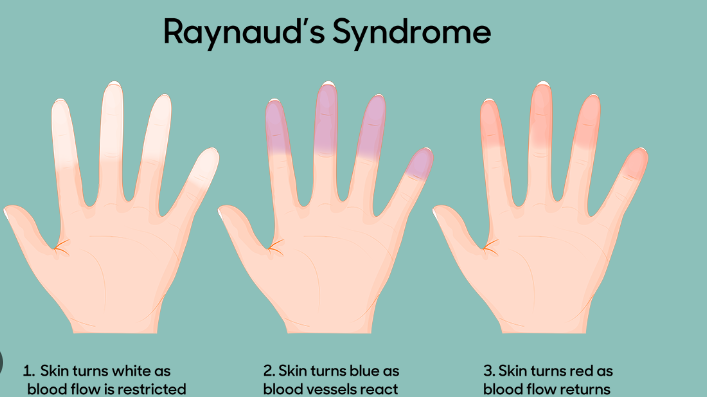With this disorder, your finger and toes are super-sensitive to cold of raynaud’s syndrome
Your fingers start off chilly and swollen, turning blue and white as they become numb. Your fingertips then quiver and turn red as the unpleasant return to sensation sets in upon rewarming.
Raynaud’s syndrome can occur from exposure to extremely cold winter weather, intense office air conditioning, or even from merely reaching into the freezer to get some ice. The body overreacts to cold or, in certain situations, stress when someone has Raynaud’s syndrome, which results in severely decreased circulation to the extremities. Fingers and toes are the most commonly affected areas by Raynaud’s disease; the earlobes, lips, nose, and nipples are less commonly affected.
Also read-Cohabiting With A Depression Relative Can Have A Financial And Mental Burden

Raynaud’s Syndrome
Types
Raynaud’s is classified as either primary or secondary Raynaud’s. The two types differ markedly as far as who they affect and their impact on the body.
- Primary Raynaud’s.
- Secondary Raynaud’s.

Raynaud’s Syndrome
Causes
No definitive cause has been established for primary Raynaud’s syndrome. However, because it commonly runs in families, often begins in adolescence and tends to improve with age, it’s believed to be inheritable, Wigley says.

For secondary Raynaud’s syndrome, several types of medical conditions may be responsible. Disease-related causes of secondary Raynaud’s include the following:
- Autoimmune conditions, including rheumatoid arthritis and lupus.
- Disorders of the connective tissues, such as scleroderma.
- Atherosclerosis is the term for artery hardening.
- A rare condition called Buerger’s disease affects the veins and arteries in the arms and legs.
- Thyroid conditions such as hypothyroidism (insufficient thyroid hormone).
- A form of high blood pressure that affects the arteries in the heart and lungs is called pulmonary hypertension.
- An inflammatory muscle disorder is called polymyositis.
- Blood conditions, including cryoglobulinemia and polycythemia.
- Secondary Raynaud’s disease can also result from specific exposures or injuries.
- Vibration damage to hands and arms by using tools like jackhammers repeatedly.
- Smoking cigarettes or being around smoke.
- Trauma or damage from repetitive action to the fingers or wrist.
- adverse effects of medication.
- exposure to chemicals such as vinyl chloride, a gas used in the production of plastic goods.

Symptoms
Situations or environments that would cause mild discomfort for most people can set off prolonged symptoms in people with Raynaud’s syndrome. Scenarios like these can trigger an exaggerated physical response.
- Cold, wet winter weather.
- Air conditioning in buildings.
- Freezer aisles of grocery stores.
- Direct contact with items like a glass filled with ice cubes.
- Emotional stress.

Diagnosis
Diagnosing Raynaud’s typically involves several steps. First, doctors confirm that you actually have Raynaud’s itself. It’s a photographic diagnosis, Gerhard-Herman says. “When people come in with Raynaud’s phenomenon, either they’re displaying it when they come in or they have pictures—often on their cellphones nowadays—and we see a very well-demarcated white or blue, often of the fingers or toes,” she says. However, appearance isn’t the only feature. “You can’t have a blue finger all the time when you have Raynaud’s phenomenon,” Gerhard-Herman explains. “It has to be something that comes and goes.”

Treatments
Educating patients about Raynaud’s syndrome so they understand their condition is the most effective treatment, Wigley says. With primary Raynaud’s in particular, treatment is typically focused on lifestyle measures to avoid triggers that aggravate symptoms.
Lifestyle Changes
Your health care team will talk about self-care and preventive strategies like these:
- Wear a hat, mittens, a coat with snug cuffs and a scarf in cold weather. Layer clothing underneath.
- Place hand and foot warmers in outdoor clothing.
- Wear warmer clothing, like gloves, in the freezer aisle in grocery stores.
- Indoors, turn the air conditioning temperature up if possible.
- Dress warmly indoors, including wearing thermal underwear if needed.
- Use insulated mugs or drinking glasses.
- Use warm water to quickly warm up cold hands.
- Limit the use of drills and other vibrating tools.
- Wear protective gear if you do work that involves industrial chemicals.
- Take steps to reduce and manage stress.
- Stop smoking and avoid secondhand smoke.
- Go over any medications you take with your doctor. Certain prescription medications to treat attention deficit hyperactivity disorder, cancer and high blood pressure can trigger Raynaud’s, as can some over-the-counter drugs.

Also read-Norovirus : A Patient’s Guide To Norovirus And Its Symptoms
images source: Google
Disclaimer: The opinions and suggestions expressed in this article are solely those of the individual analysts. These are not the opinions of HNN. For more, please consult with your doctor




































